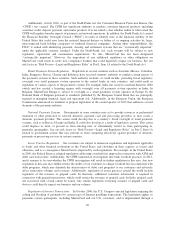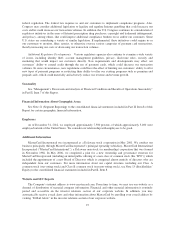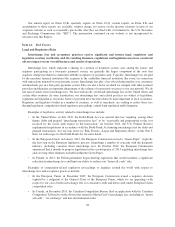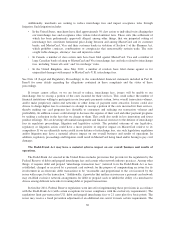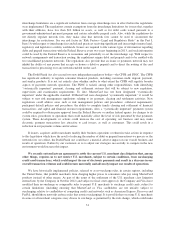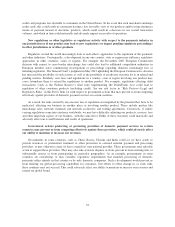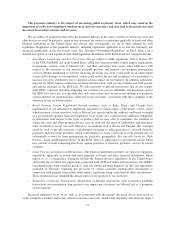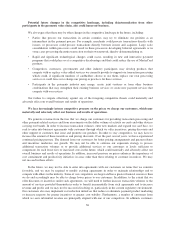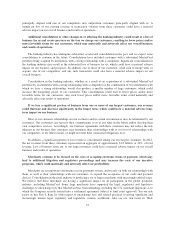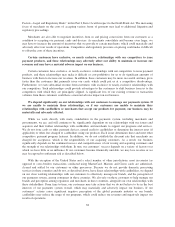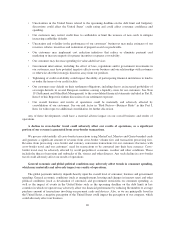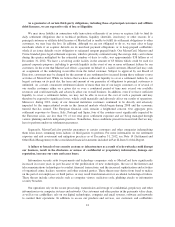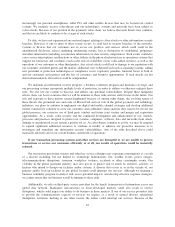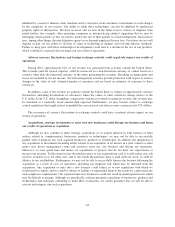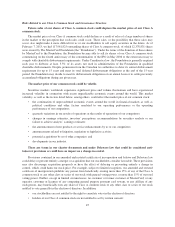MasterCard 2012 Annual Report Download - page 40
Download and view the complete annual report
Please find page 40 of the 2012 MasterCard annual report below. You can navigate through the pages in the report by either clicking on the pages listed below, or by using the keyword search tool below to find specific information within the annual report.Potential future changes in the competitive landscape, including disintermediation from other
participants in the payments value chain, also could harm our business.
We also expect that there may be other changes in the competitive landscape in the future, including:
• Parties that process our transactions in certain countries may try to eliminate our position as an
intermediary in the payment process. For example, merchants could process transactions directly with
issuers, or processors could process transactions directly between issuers and acquirers. Large scale
consolidation within processors could result in these processors developing bilateral agreements or in
some cases processing the entire transaction on their own network, thereby disintermediating us.
• Rapid and significant technological changes could occur, resulting in new and innovative payment
programs that could place us at a competitive disadvantage and that could reduce the use of MasterCard
products.
• Competitors, customers, governments and other industry participants may develop products that
compete with or replace value-added services we currently provide to support our transaction processing
which could, if significant numbers of cardholders choose to use them, replace our own processing
services or could force us to change our pricing or practices for these services.
• Participants in the payments industry may merge, create joint ventures or form other business
combinations that may strengthen their existing business services or create new payment services that
compete with our services.
Our failure to compete effectively against any of the foregoing competitive threats could materially and
adversely affect our overall business and results of operations.
We face increasingly intense competitive pressure on the prices we charge our customers, which may
materially and adversely affect our business and results of operations.
We generate revenue from the fees that we charge our customers for providing transaction processing and
other payment-related services and from assessments on the dollar volume of activity on cards and other devices
carrying our brands. In order to increase transaction volumes, enter new markets and expand our card base, we
seek to enter into business agreements with customers through which we offer incentives, pricing discounts and
other support to customers that issue and promote our products. In order to stay competitive, we may have to
increase the amount of these incentives and pricing discounts. Over the past several years, we have experienced
continued pricing pressure. The demand from our customers for better pricing arrangements and greater rebates
and incentives moderates our growth. We may not be able to continue our expansion strategy to process
additional transaction volumes or to provide additional services to our customers at levels sufficient to
compensate for such lower fees or increased costs in the future, which could materially and adversely affect our
overall business and results of operations. In addition, increased pressure on prices enhances the importance of
cost containment and productivity initiatives in areas other than those relating to customer incentives. We may
not succeed in these efforts.
In the future, we may not be able to enter into agreements with our customers on terms that we consider
favorable, and we may be required to modify existing agreements in order to maintain relationships and to
compete with others in the industry. Some of our competitors are larger and have greater financial resources than
we do and accordingly may be able to charge lower prices to our customers. In addition, to the extent that we
offer discounts or incentives under such agreements, we will need to further increase transaction volumes or the
amount of services provided thereunder in order to benefit incrementally from such agreements and to increase
revenue and profit, and we may not be successful in doing so, particularly in the current regulatory environment.
Our customers also may implement cost reduction initiatives that reduce or eliminate payment product marketing
or increase requests for greater incentives or greater cost stability. Furthermore, a number of customers from
which we earn substantial revenue are principally aligned with one of our competitors. In addition, customers
36


